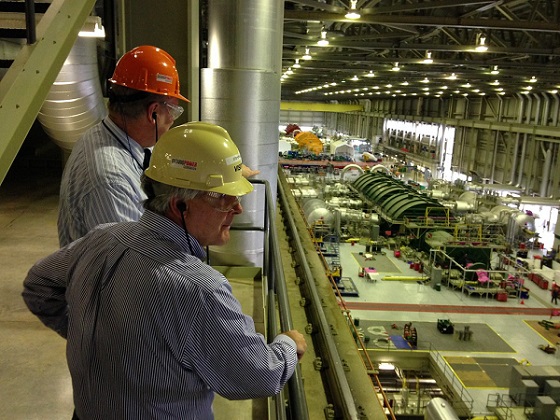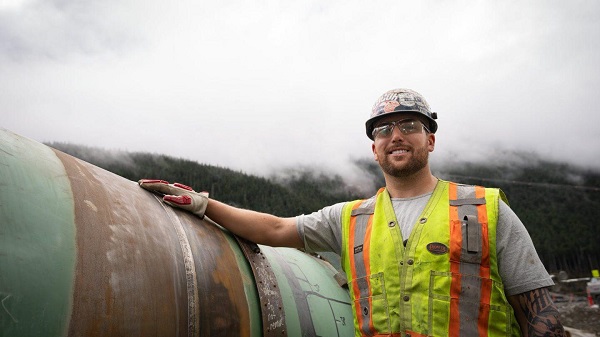Energy
Is Canada the next nuclear superpower?

From Resource Works
The rise of AI and other technologies have pushed energy demand through the roof, and Canada can help power that with nuclear.
Good to see Prime Minister Justin Trudeau pushing nuclear power as a key contributor to meeting the world’s soaring demand for electricity.
“The energy consumption necessary around AI (artificial intelligence) nobody has properly understood yet,” he said. “We have stepped up big time on nuclear.”
He cited Canada’s uranium reserves and progress in building both full-scale CANDU reactors and small modular reactors (SMRs). He said other countries need to “skate where the puck is going” on cleaner energy sources.
“We know that if we are going to meet our net-zero targets around the world, and certainly in this region, nuclear is going to be really part of the mix.”
He stopped short of saying Canada would build more major nuclear reactors for domestic use but spoke about the development of SMRs. Ottawa has previously stated it wants to become “a global leader in SMR deployment.”
Meanwhile, International Trade Minister Mary Ng said Canada is launching a gateway for nuclear development in the Asia-Pacific region. She said growing Pacific Rim economies will face increasing demand for electricity, not just to curb emissions.
“All this followed CANDU licence-holder AtkinsRéalis announcing a “multi-billion-dollar” sale of two CANDU reactors to Romania, the first to be built since 2007. The federal government contributed $3 billion, the company said.
And in one of our Resource Works Power Struggle podcasts, energy journalist Robert Bryce said: “We’re seeing the revitalization of the nuclear sector… There are a lot of promising signs.”
Also from Bryce: “Forty-seven per cent of the people on the planet today live in electricity poverty. There are over three billion people who live in the unplugged world; 3.7 billion who live in places where electricity consumption is less than what’s consumed by an average kitchen refrigerator.”
Policy Options magazine notes how Canada and 21 other countries signed a 2023 pledge to triple nuclear energy capacity by 2050, and says: “The reality would appear to be clear: there is no feasible net-zero future without the deployment of new nuclear power.”
For Canada, it adds: “We have an opportunity to expand our global status, but this requires overcoming years of policy inaction while other nations have modernized their nuclear strategies. To triple our nuclear capacity by 2050, we need clear priorities and unwavering political commitment.”
Earlier this year, François-Philippe Champagne, federal minister of innovation, science and industry, said nuclear power needs to grow for the world’s renewable-energy economy.
“Nuclear, definitely. For me, we have to look at hydro, we have to look at nuclear, we have to look at small modular reactors, we have to look at wind, we have to look at solar.”
Jonathan Wilkinson, energy and natural resources minister, promised to expedite the approval process for new Canadian nuclear projects.
Canada now gets about 15% of its electricity from nuclear generation, mostly from reactors in Ontario.
But the last nuclear reactor to come into service in Canada was at the Darlington station, east of Toronto, back in 1993. No new nuclear project has been approved since then, but multi-million-dollar upgrades are underway at existing Ontario plants.
Heather Exner-Pirot of the Macdonald-Laurier Institute and Jesse McCormick of the First Nations Major Projects Coalition see SMRs and micro-reactors as a plus for rural and remote areas of Canada that now rely on diesel to generate power. Some First Nations are also interested.
However, the two commentators point out that nuclear developers will need Indigenous support and will have to “provide meaningful economic benefits and consider Indigenous perspectives in project design.”
Now, the Wabigoon Lake nation in Ontario has stepped up as a potential host to a deep underground facility for storing nuclear waste.
As Canada looks to SMRs to meet electricity demand, our country also hopes to sell more uranium to other nations—perhaps with a little help from Russia.
In October, Russian President Vladimir Putin proposed restrictions on Russian uranium exports in retaliation for Western sanctions on Russian oil, gas, and LNG.
That boosted hopes for increased exports of Canadian uranium.
Canada, once the world’s largest uranium producer, is now the world’s second-largest, behind Kazakhstan, and accounts for roughly 13% of global output.
Putin’s threat gave more momentum to the plans underway by NexGen Energy for its $4-billion Rook 1 uranium mine in Saskatchewan.
The Canadian Nuclear Safety Commission has completed its final technical review of the project. Next comes a commission hearing, followed by a final decision on approval.
NexGen is working on detailed engineering plans in preparation for full construction, pending federal approval.
NexGen could push Canada to become the world’s largest uranium producer over the next decade. Other companies are rushing to Saskatchewan to start exploration projects in the Athabasca region, while existing players are reopening dormant mines.
All this follows the commitment by nearly two dozen countries in 2023 to triple their nuclear-energy output by 2050.
And so Britain’s BBC News topped a recent roundup on nuclear power with this headline: “Why Canada could become the next nuclear energy ‘superpower’.”
2025 Federal Election
Mark Carney Wants You to Forget He Clearly Opposes the Development and Export of Canada’s Natural Resources

From Energy Now
At COP26, Mark Carney also said that he thinks “we have both far far too many fossil fuels in the world” and “as much as half of oil reserves, proven oil reserves need to stay in the ground” climate goals.
Mark Carney claims that he supports Canada’s oil and gas industry and wants to see Canada export more of our natural resources. But Carney is yet again lying.
If Carney was sincere, he would immediately commit to the full repeal of the Liberals’ C-69, the ‘No More Pipelines’ Act, C-48, the West Coast Tanker Ban, and the production cap. Instead he doubled down on capping Canadian energy production.
But it’s not just that, Mark Carney has a clear history of opposing Canadian energy and infrastructure projects in favour of his radical anti-energy ideology and his goal of shutting down Canadian energy production.
However, while deliberately fighting against Canadian energy, this high flying hypocrite was having his company, Brookfield Asset Management, invest in some of the largest global pipeline projects in Brazil and the United Arab Emirates.
When asked by Conservative Party Leader Pierre Poilievre at an Industry Committee meeting, if he supported Justin Trudeau’s decision to veto the Northern Gateway pipeline, Mark Carney said “given both environmental and commercial reasons … I think it’s the right decision.”
Then, just six months later at COP26, Mark Carney also said that he thinks “we have both far far too many fossil fuels in the world” and “as much as half of oil reserves, proven oil reserves need to stay in the ground” climate goals.
If this wasn’t enough Mark Carney has now teamed up with Trudeau’s radical anti-energy ministers to finish off Canada’s energy sector, a goal that he has outlined while attending a World Economic Forum event in Davos.
Starting with the radical, self-proclaimed socialist, Steven Guilbeault, who’s history of anti-energy and infrastructure policies is all too familiar to Canadians.
Mark Carney has enabled Steven Guilbeault to do even more damage by promoting him to his Quebec Lieutenant, giving him three new ministerial responsibilities so he can continue his climate crusade against Canadian energy and infrastructure projects.
Canadians remember when Guilbeault said that “I disagree with the [Trans Mountain] pipeline” and that “Canada shouldn’t be investing in new infrastructure for fossil fuels.”
They also remember when he proudly proclaimed that “Our government has made the decision to stop investing in new road infrastructure.” All from a minister who shamed Canadians for owning cars.
Then there is the pipeline hating Jonathan Wilkinson, who Carney appointed as Canada’s Minister of Energy and Natural Resources. Recently, Wilkinson wrote a scathing letter to Canada’s energy leaders for their opposition to the Carney-Trudeau Liberals production cap on Canadian oil and gas.
Despite Canadian industries being subject to unjustified tariffs from the United States, Jonathan Wilkinson recently told reporters that “Everybody’s sort of running around saying, ‘Oh my God, we need a new pipeline, we need a new pipeline.’ The question is, well, why do we need a new pipeline?”
Finally, there is Carney’s new Minister of Environment and Climate Change Terry Duguid. Duguid has doubled down on Mark Carney’s climate radicalism by stating that “a Mark Carney government will maintain the cap on emissions from the production of oil and gas”.
From 2015 to 2021 Carney-Trudeau environmental and anti-industry policies have cancelled over $176 billion in Canadian energy projects, with many more being cancelled afterwards. That means $176 billion worth of jobs and powerful paycheques have been blocked from Canadians so Mark Carney and his Ministers can impose their radical net zero ideology.
2025 Federal Election
Canada’s pipeline builders ready to get to work

From the Canadian Energy Centre
“We’re focusing on the opportunity that Canada has, perhaps even the obligation”
It was not a call he wanted to make.
In October 2017, Kevin O’Donnell, then chief financial officer of Nisku, Alta.-based Banister Pipelines, got final word that the $16-billion Energy East pipeline was cancelled.
It was his job to pass the news down the line to reach workers who were already in the field.
“We had a crew that was working along the current TC Energy line that was ready for conversion up in Thunder Bay,” said O’Donnell, who is now executive director of the Mississauga, Ont.-based Pipe Line Contractors Association of Canada (PLCAC).
“I took the call, and they said abandon right now. Button up and abandon right now.
“It was truly surreal. It’s tough to tell your foreman, who then tells their lead hands and then you inform the unions that those three or four or five million man-hours that you expected are not going to come to fruition,” he said.

Workers guide a piece of pipe along the Trans Mountain expansion route. Photograph courtesy Trans Mountain Corporation
“They’ve got to find lesser-paying jobs where they’re not honing their craft in the pipeline sector. You’re not making the money; you’re not getting the health and dental coverage that you were getting before.”
O’Donnell estimates that PLCAC represents about 500,000 workers across Canada through the unions it works with.
With the recent completion of the Trans Mountain expansion and Coastal GasLink pipelines – and no big projects like them coming on the books – many are once again out of a job, he said.
It’s frustrating given that this could be what he called a “golden age” for building major energy infrastructure in Canada.
Together, more than 62,000 people were hired to build the Trans Mountain expansion and Coastal GasLink projects, according to company reports.
O’Donnell is particularly interested in a project like Energy East, which would link oil produced in Alberta to consumers in Eastern and Atlantic Canada, then international markets in the offshore beyond.
“I think Energy East or something similar has to happen for millions of reasons,” he said.
“The world’s demanding it. We’ve got the craft [workers], we’ve got the iron ore and we’ve got the steel. We’re talking about a nation where the workers in every province could benefit. They’re ready to build it.”

The “Golden Weld” marked mechanical completion of construction of the Trans Mountain Expansion Project on April 11, 2024. Photo courtesy Trans Mountain Corporation
That eagerness is shared by the Progressive Contractors Association of Canada (PCA), which represents about 170 construction and maintenance employers across the country.
The PCA’s newly launched “Let’s Get Building” advocacy campaign urges all parties in the Canadian federal election run to focus on getting major projects built.
“We’re focusing on the opportunity that Canada has, perhaps even the obligation,” said PCA chief executive Paul de Jong.
“Most of the companies are quite busy irrespective of the pipeline issue right now. But looking at the long term, there’s predictability and long-term strategy that they see missing.”
Top of mind is Ottawa’s Impact Assessment Act (IAA), he said, the federal law that assesses major national projects like pipelines and highways.
In 2023, the Supreme Court of Canada found that the IAA broke the rules of the Canadian constitution.
The court found unconstitutional components including federal overreach into the decision of whether a project requires an impact assessment and whether a project gets final approval to proceed.
Ottawa amended the act in the spring of 2024, but Alberta’s government found the changes didn’t fix the issues and in November launched a new legal challenge against it.
“We’d like to see the next federal administration substantially revisit the Impact Assessment Act,” de Jong said.
“The sooner these nation-building projects get underway, the sooner Canadians reap the rewards through new trading partnerships, good jobs and a more stable economy.”
-

 2025 Federal Election2 days ago
2025 Federal Election2 days agoOttawa Confirms China interfering with 2025 federal election: Beijing Seeks to Block Joe Tay’s Election
-

 COVID-192 days ago
COVID-192 days agoNearly Half of “COVID-19 Deaths” Were Not Due to COVID-19 – Scientific Reports Journal
-

 2025 Federal Election2 days ago
2025 Federal Election2 days agoHow Canada’s Mainstream Media Lost the Public Trust
-

 2025 Federal Election1 day ago
2025 Federal Election1 day agoBREAKING: THE FEDERAL BRIEF THAT SHOULD SINK CARNEY
-

 2025 Federal Election2 days ago
2025 Federal Election2 days agoPOLL: Canadians want spending cuts
-

 John Stossel1 day ago
John Stossel1 day agoClimate Change Myths Part 2: Wildfires, Drought, Rising Sea Level, and Coral Reefs
-

 2025 Federal Election1 day ago
2025 Federal Election1 day agoCHINESE ELECTION THREAT WARNING: Conservative Candidate Joe Tay Paused Public Campaign
-

 Media1 day ago
Media1 day agoCBC retracts false claims about residential schools after accusing Rebel News of ‘misinformation’







